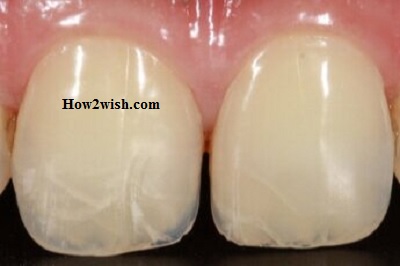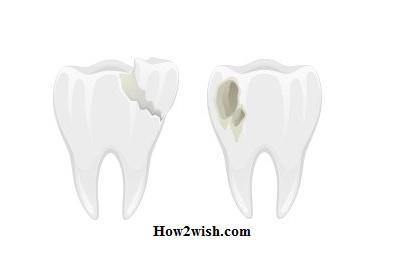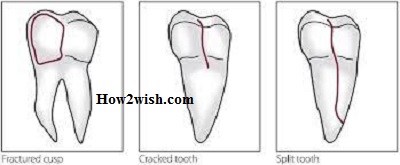Before getting rid of cracked teeth, the doctor prescribing treatment should carefully examine the damaged units, conduct other diagnostic studies and find out the exact cause of the problem. There are many factors that can cause scratches and breaks. The patient should not ignore such symptoms, because over time they can develop into a serious pathological process that requires long-term therapy and rehabilitation. Refusal to visit a doctor often leads to the loss of incisors, canines, and molars. Compliance with preventive recommendations significantly reduces the risks.

What are teeth cracks?
This is a split in the enamel, which can be quite deep or affect only the surface layers. At the same time, the unit does not have contrasting pigmentation, is not broken, and does not loosen.
Cracked crowns cause pain. If the defect is small, only an experienced dentist will be able to notice it during the examination. Larger damage is visible to the naked eye. They are especially visible after drinking coloring drinks (coffee, tea, soda).
Even when the crack is extremely small, mandatory medical intervention is required. An insignificant strip of hard tissue increases with time becomes deeper and leading to the loss of not only the crown part but also the roots.
Causes of cracked teeth enamel
There are several factors:
- Mechanical impact. The person may be hit or otherwise injured. It is also possible if you nibble on nuts or eat other solid foods.
- Deficiency of vitamins and minerals. When the body lacks fluorine, calcium, and other essential substances, the top layer of incisors, canines, and molars becomes thinner and more susceptible to irritants.
- Temperature fluctuations. This happens with the simultaneous use of hot and cold.
- Bruxism. Pathology leads to the deterioration of bone tissue, abrasion, and destruction.
- Use of pastes with abrasives. With their regular use, the side and front teeth crack, as if cracks appear on them, as well as scratches intersecting with each other. Large particles lead to thinning of the enamel. The protective layer is erased and can no longer perform its functions.
- Dentist error. With poor-quality treatment and some cosmetic manipulations, the doctor can damage the surface with tools.
- Food in the diet contains a large number of acids (for example, citrus fruits, and berries) and chemical dyes (sweet soda). At first, a person notes a significant increase in sensitivity.
- Taking certain medications (antibacterial drugs, etc.).
- Installing and wearing braces.
- Smoking and other bad habits (picking your mouth with nails, hard objects).
- Insufficient hygiene care for the oral cavity.
- Bite anomalies.
What are dangerous teeth cracks?
If such a problem is discovered, the consequences can be very serious. For example, in some cases, it is unavoidable to remove a unit. If therapy is not started in a timely manner, scratches with regular loads will turn into wide fractures, the pathological process will affect the deeper layers (dentin).
What is the danger:
- A damaged incisor, canine, or molar is not protected from external influences. As a result, sensitivity progresses, especially if a person consumes cold, hot, sweet, and sour foods. There is pain when biting food.
- Food particles, plaque, and pathogenic microorganisms accumulate in the cracks. This is a favorable environment for the appearance and growth of caries, periodontitis, and pulpitis.
- Chipping is considered a common complication. Because of this, injury occurs to the gums, tongue, and the inside of the cheeks. Injuries to the mucous membranes complicate the symptoms and lead to a deterioration in well-being.
- Loss of a unit. This is an irreversible consequence. If the crown is completely split, and restoration is impossible, the dentist performs an extraction. Otherwise, the risk of infection of the pulp increases.
- The presence of psychological discomfort. A person feels unattractive due to unaesthetic small stripes on the teeth.
Crack classification
In dentistry, there are several common types of such damage. Each of them has its own characteristics and carries a certain health hazard. Untimely diagnosis and treatment significantly reduce the likelihood of saving a unit.
What are the cracks (microcracks) on the teeth:
- Vertical. The crown and deep root regions are affected. If the phenomenon has spread to the entire length of the incisor, canine, or molar, no restorative and restoration measures will help. The doctor performs an extraction.
- Horizontal. In the absence of therapeutic intervention, chips are formed. The closer the scratch is to the gum, the higher the risk of chipping.
- Inclined. The defect runs diagonally. Ignoring the symptoms leads to the development of pathogenic microflora and caries.
- Internal. Not easy to find. Detected with an x-ray. Most often, patients go to the dental clinic after a fracture provoked by such a crack in the teeth (how to remove, how to treat – we will consider below).
- root. The split goes through the root. With extensive damage, removal cannot be avoided.
- At the base. Since the dentin layer also suffers, inflammation is observed, and pain is felt.
Also, cracks are divided into deep, superficial, and multiple. Not all of them are accompanied by unaesthetic, so it is important to pay attention to the accompanying manifestations.
Additional symptoms
The problem is visible to the naked eye if it concerns the front incisors. In other cases, most often the damaged surface is not noticeable. Therefore, patients often go to the clinic when the tissues are already severely destroyed.
Auxiliary symptoms indicating a pathological process:
- Pain sensations of uncertain localization;
- Increased sensitivity to hot and cold;
- Discomfort when chewing food;
- Unpleasant odor from the mouth;
- Inflammation of the mucous membranes in the mouth;
- Change in the shade of enamel
- Bleeding when pressing one.
Diagnostic methods
When the first suspicious signs appear, you should visit a dentist. Doctors of Dentika not only conduct a visual examination but also use special tools. To determine the location and degree of tissue damage, an X-ray examination is prescribed. What to do if a crack appears inside the tooth is decided based on the results of diagnostic procedures.
Numerous scratches are found without the use of tools. Deep ones can only be seen under the influence of light, while the surfaces are dried with cotton balls. Surface flaws are detected with a magnifying glass or in a special way – transillumination.
Preventing and Treating Diseases of the Teeth and Oral Cavity
Making an accurate diagnosis can be difficult. This is due to the frequent absence of characteristic symptoms. Specialists take into account all the manifestations in the aggregate: the patient’s feelings, his anamnesis, x-ray, and exacerbation of symptoms during the treatment process.
All methods are combined because in this way the dentist will be able to objectively assess the situation and develop a therapeutic regimen. For this it is used:
- Instrumental examination of the oral cavity;
- Examination under a microscope;
- Translucence;
- Staining with contrast agents.
In some cases, exploratory surgery is indicated. This is the exfoliation of dentin particles and the removal of granulation tissue for subsequent coloring of the damaged layer. Thus, even microcracks are visualized. Sometimes a root resection is performed.
Treatment of horizontal and vertical teeth crack the enamel
Therapeutic tactics are developed exclusively by a specialist based on the results of diagnosis, size, and localization of cracking. The most commonly used methods are:

- Remineralization. A special composition containing a large amount of calcium and fluorine is applied to the surface. As a result, the units become smooth, and hypersensitivity disappears.
- Restoration. The chipping fragment is removed and replaced with a composite overlay.
- Veneers. Suitable if the defects are shallow but numerous. Before use, it is necessary to treat caries and other pathologies.
- Crowns. Applicable for cracks along the length of the entire unit. Mounted on cement or bridge.
- Depulping. When the pulp is severely damaged, it is removed. With a partial lesion, dentists extract only the pathological elements of the nerves.
- Extraction. A radical method is indicated in the case when the incisor, canine, or molar cannot be saved. During surgery, local anesthesia is used.
Why You Might Need Tooth Extraction
When, according to indications, you need to remove a unit, you should not try to save it. The fact is that even when restoring after a while, you will have to remove the damaged element. However, further implantation and prosthetics can be difficult.
Getting rid of cracked parts is also carried out due to inflammation in the oral cavity. If you leave everything as it is, it will negatively affect the state of all elements.
What to do if the child’s enamel is cracked
Babies are constantly putting things into their mouths. This leads to injury to the units. What do cracked teeth look like in preschoolers (causes and symptoms of the pathology are listed above)? Outwardly, the defect does not differ from similar problems in adults, but it does not cause such severe consequences.
Over time, the bite will change to a permanent one, so the situation should not be a cause for alarm, but it is necessary to visit a doctor in any case. Some types of damage affect the formation of root rows. And on examination, hidden pathologies and injuries are often revealed.
If pain is present, you can give your child a mild pain medication recommended by experts. You also need to make sure that the baby does not put his hands in his mouth.
What to do if there is a crack in the tooth enamel of the front tooth
You can see the problem yourself. But it is important to immediately contact the dentist for the appointment of therapy. Preliminary restoration measures are shown to strengthen the structure.
Usually, surfaces are treated with compositions containing valuable minerals. The voids, if necessary, are filled with polymers.
The procedure for the presence of microcracks in the front:
- Cleaning the enamel layer;
- Polishing and grinding;
- Fluoride treatment.
It is worth taking care of the absence of diseases in the oral cavity in advance. Otherwise, the inside of the units may be infected, leading to their final cracking.
What to do if a crack appears on a tooth – help at home
Attempts to restore the integrity of the scratched layer on your own will not bring any result. If you do something wrong, it will affect neighboring units. Treatment should be done by a doctor.
At home, it is recommended to treat the surface with an antiseptic solution. This prevents the development of the inflammatory process. In the presence of pain and other discomfort, drugs with an anesthetic effect are indicated.
It is important to refuse food before the appointment with a specialist. When this is not possible, it is worth chewing food on the healthy side. If the defect is deep, brushing should not be done until a visit to the doctor.
Cracks while wearing braces or after removing them
Damage can appear even after the most harmless procedures. For example, this applies to bleaching. Prolonged use of the orthodontic system also leads to the deterioration of the enamel layer. For this reason, after a therapeutic course, restorative remineralizing therapy is indicated.
To prevent the design from causing scratches, you need to follow simple recommendations:
- Regular hygienic care of the oral cavity;
- Using an irrigator for better cleansing;
- The use of a special bracket brush for cleaning;
- Enzyme rinses at home.
In case of violation of the integrity of the seal, its replacement is indicated. If necessary, caries are treated. Inexperienced dentists sometimes advise grinding the surface to get rid of discomfort, but this option is unacceptable.
If a defect appears on an artificial crown, the prosthesis is dismantled, and the doctors examine the patient. Further therapeutic tactics depend on the localization of the problem and the depth of the damage.

Preventive actions
In order not to think about how to understand that the enamel on the front tooth has cracked, and what to do if the crown is still damaged, you must follow simple rules:
- Take proper care of your mouth. You need to use a good-quality brush and paste. Additionally, it is recommended to purchase an irrigator. After meals, it is important to rinse your mouth with a special mouthwash or clean the interdental spaces with a floss (floss).
- 1-2 times a week, dentists advise cleaning with compounds containing fluoride. Constantly such means are not used, since an excess of a substance is just as dangerous as its shortage.
- When eating, do not combine hot and cold dishes at the same time. Let the food be at a comfortable warm temperature.
- The diet should include a lot of fresh vegetables and fruits, herbs, fish, cottage cheese, and cheese. It is necessary to avoid sweets, pastries, and soda with flavors and dyes.
- It is worth giving up smoking and other bad habits that provoke the cracking of hard tissues.
- Regularly visit the dentist for preventive purposes at least 1 time every six months.
- Do not resort to professional dental procedures if there are contraindications.
- Take vitamin and mineral complexes, selected by the doctor.
Final Thought on How to Fix Cracked Teeth Naturally
If a person has a vertical crack in the front tooth, “how to treat” and “what to do” become the main questions. Tactics of treatment depend on the degree of damage, location, and size of the defect. If you consult a doctor in a timely manner, the therapy will pass quickly and without consequences. However, it is best not to allow the development of the pathological process, but to take all possible preventive measures to prevent the destruction of enamel.
